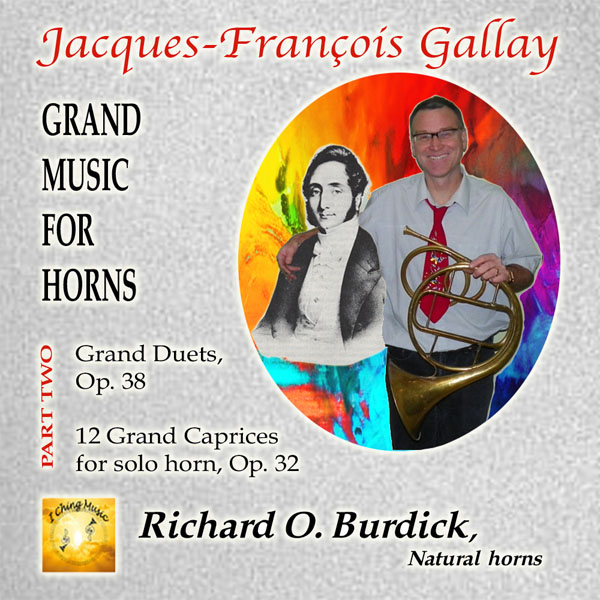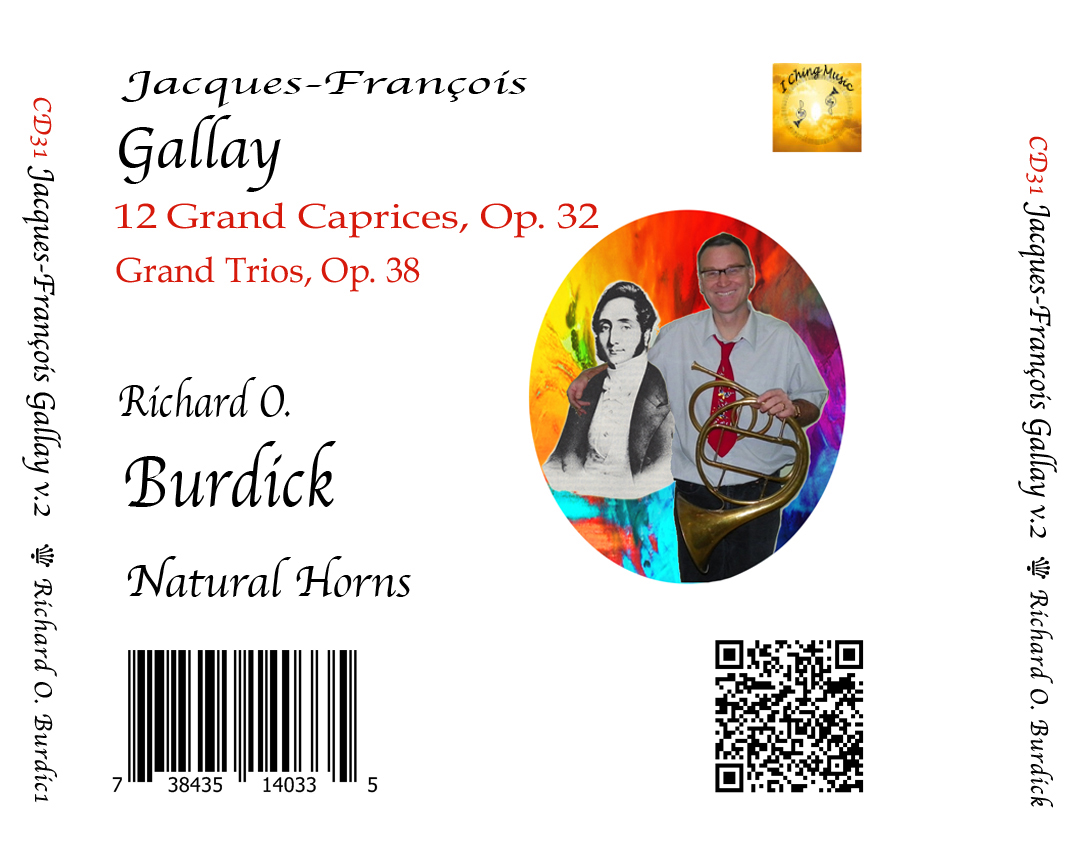
Grand Duets, opus 38 & Twelve Grand Caprices, opus 32
Grand Duet No. 1, Op. 28: 1
Grand Duet No. 2, Op. 28: 2
Grand Duet No. 3, Op. 28: 3
12 Grand Caprices, Op. 32
Released: c. 2021
Richard Burdick’s two CD’s released as C30 & CD31 are both of music which Gallay used the term “Grand” in the title. These harks back to the terrific music of his teacher: Dauprat with his very popular grand sextet.
These CD’s are recorded on natural horn, most in Eb with the tuning pitch center @ A = 432
Jacques-François Gallay was born in 1795 in Perpignan, France, where he received his earliest horn instruction from his father. At the age of 25, he was admitted to Dauprat’s
horn class despite the fact that he was above the normal age for admission. He won a premier prix after his first year of study, and was soon performing regularly in professional Parisian ensembles.
During the classical period in music, horn players were trained either as high players or low players. Gallay was, by nature, a cor alto (high player), but many of his exercises and solo pieces are written in the relatively narrow range of the cor mixte (a middle range playing style). He is considered by some to be the “last great hand horn virtuoso in France,” but he received mix criticism such as:“he went up like an angel, but could not go down”. The only adverse criticism of Gallay’s playing which appeared justified was in regard to the limited range which he used on the horn. He seemed to wish, like Frédéric Duvernoy, to circumscribe himself within the limits of the Cor mixte, resulting in a certain monotony that the greatest perfection of detail could not obliterate.
Gallay was appointed to the Paris Conservatoire to succeed his teacher, Dauprat, as professor of hand horn. His Préludes mesurés et non-mesurés, Op. 27, had appeared only a few years before this appointment. Approximately three years later, in 1845, he produced his Méthode pour le Cor, the last major nautral horn tutor.
Gallay died October 18, 1864 while still engaged in his position at the Conservatoire. It was not until 1903 that the valve horn became the officially recognized horn at the Paris Conservatoire and many authors attribute the remarkable delay in its acceptance to Gallay and his excellent hand horn playing and teaching.



About the Recording:
Richard Burdick as a musician:
French hornist: Richard O. Burdick is the first horn of Regina Symphony Orchestra and the Regina Symphony Chamber Players in Regina, Saskatchewan, Canada. He is a prolific composer.
His move to Canada in 2003, with his wife Rebecca and his two boys, marked the start of the fourth major period in his musical Career.
In the 1980’s Richard was first Horn of Napa Symphony, a member of a San Francisco based theater orchestra and played lots of chamber music as manager of Trinity Chamber Concerts, a chamber music series in Berkeley California.
Starting in 1990 he played fourth Horn full-time for Sacramento Symphony, which went bankrupt in 1996. He then won auditions for Fresno Philharmonic, Napa & North State Symphonies and played in Sacramento Philharmonic & Opera.
He is a prolific composer and has many self produced CD’s of his own compositions, Bach, his classical natural horn playing and multi-track performances of many of his favorite pieces.
He performs on a variety of horns, a baroque natural horn (1720), a classical era natural horn (1800), a romantic era (1840's) natural horn, a single F horn from the 1880's, his main symphony horn is a Brendan Model Finke triple horn.
He has also done many music related jobs such as arranger for Sacramento Symphony, librarian and personal manager for Sacramento Philharmonic, and manager of Trinity Chamber Concerts (chamber music series) in Berkeley, California for 19 years starting in 1984.
![]()
![]()
ISRC
Would you like to comment on this work?We would appreciate comments,
|
|---|
Grand Duet No. 1, Op. 38: 1. Maestoso
Grand Duet No. 1, Op. 38: 2. Adagio poco andante
Grand Duet No. 1, Op. 38: 3. Allegretto Risoluto
Grand Duet No. 2, Op. 38: 1. Allegro poco agitato
Grand Duet No. 2, Op. 38: 2. Andante con moto
Grand Duet No. 2, Op. 38: 3. Agitato
Grand Duet No. 3, Op. 38: 1. Allegro
Grand Duet No. 3, Op. 38: 2. Andante con moto
Grand Duet No. 3, Op. 38: 3. Finale - Presto
12 Grand Caprices, Op. 32: 1. Introduction & Allegro
12 Grand Caprices, Op. 32: 2. Allegro poco agitato
12 Grand Caprices, Op. 32: 3. Introduction & adagio
12 Grand Caprices, Op. 32: 4. Allegro vivace
12 Grand Caprices, Op. 32: 5. Minuet - Allegro moderato
12 Grand Caprices, Op. 32: 6. Allegro vivace
12 Grand Caprices, Op. 32: 7. Allegretto moderato
12 Grand Caprices, Op. 32: 8. Allegro maestoso
12 Grand Caprices, Op. 32: 9. Allegro poco agitato
12 Grand Caprices, Op. 32: 10. Introduction & maestoso
12 Grand Caprices, Op. 32: 11. Adagio quasi andante
12 Grand Caprices, Op. 32: 12.Theme & variations

738435140335
https://www.barcodelookup.com/738435140335